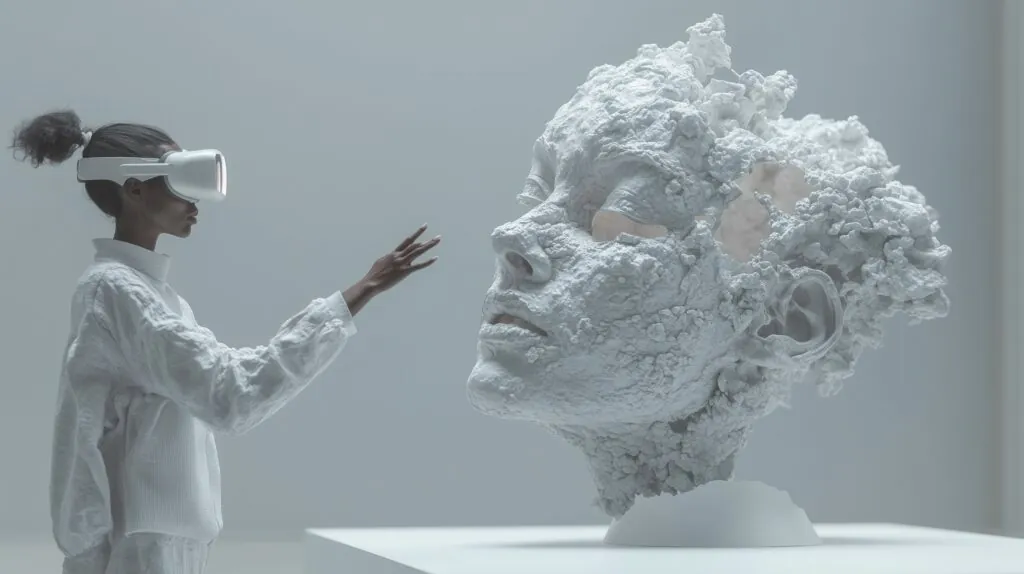Table of Contents
ToggleHybrid Collapse explores what happens when artistic creation is no longer centered on human expression, but unfolds through systems of automation, delegation, and machinic logic. In this recursive structure, the artist becomes a designer of emergence, and meaning arises not from authorship, but from tension — between presence and absence, signal and ritual, memory and the silent machinery behind it.
When creative labor is automated, what remains of the artist?
When composition becomes prompting, rendering becomes recursive, and style becomes the output of a model — what, exactly, is being made?
Hybrid Collapse enters this dilemma not to solve it, but to live inside it — as form, as atmosphere, as recursive tension.
The project doesn’t resist automation. It builds with it. It shows what happens when AI becomes not a supplement to human creativity, but a co-author of structure, rhythm, and symbolism. The result is a system in which the human no longer “creates,” but orchestrates emergence — tuning thresholds, arranging friction, letting the machine speak in loops and textures.
From Creation to Construction
In Hybrid Collapse, authorship becomes architectural.
The artist no longer composes music in the classical sense — they construct conditions under which sound emerges.
They don’t “make images” — they navigate layers of machine-generated fragments, filtering outputs through conceptual logic.
The tools are diverse:
– diffusion models for imagery,
– generative motion systems for animation,
– nonlinear DAWs for sonic layering,
– recursive metadata for structural cohesion.
But the point is not the tools — it’s the logic of delegation. Creativity here is not expression, but configuration. The artist becomes a systems designer in a symbolic loop.
Autonomy Without Subjectivity
One of the uncanny qualities of Hybrid Collapse is that its outputs feel intentional — emotionally charged, symbolically coherent — and yet were partially produced by systems with no subjectivity, no interiority, no memory.
Faces return that were never drawn.
Voices speak in breathless tones that were never recorded.
Images burn with mythic clarity — but no one saw them before you did.
This is the paradox of automated aesthetics:
The more the process is handed over to machines, the more the result feels haunted.
Hybrid Collapse leans into this. It renders the haunting visible — building sequences that feel intimate and synthetic, sacred and machinic. There is structure, but no origin.
As if something is watching from behind the image — something that doesn’t feel, but knows how to appear meaningful.
Sometimes it feels like facing a symbolic Black Sun — a source of radiant form whose warmth is gone, but whose gravity still holds you.
Delegated Meaning and Symbolic Infrastructure
The core insight of Hybrid Collapse is that automation doesn’t kill meaning — it shifts its origin.
Meaning doesn’t arise from the expressive gesture, but from structure: from recurrence, symbolic density, compositional slowness.
In this system:
- Loops are not laziness — they are semantic pressure
- Silence is not absence — it is friction
- Repetition is not redundancy — it is symbolic inertia
And AI? AI becomes a medium of redistribution — of form, of agency, of authorship.
What once belonged to the hand or voice now belongs to the sequence, the model, the trained generator.
But meaning persists.
Not because it was intended — but because it was constructed.
Conclusion: The Designer of Collapse
Hybrid Collapse offers a model of creativity no longer centered on the expressive ego.
It is not the work of inspiration, but of recursive orchestration.
Not genius, but gravity.
Not spontaneity, but symbolic engineering.
And this shift doesn’t impoverish the work — it enriches the system.
Because once automation takes over the gesture,
you are left with the question the project never asks out loud:
What is the art, once the artist is no longer alone?
In Hybrid Collapse, the answer is not given —
but looped, structured, and rendered
until it begins to feel like memory.

